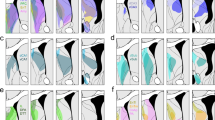Conclusions
-
1.
The dominant factor in the “tuning” of single brain neurons to special external environmental stimuli is the internal need and the dominant motivation arising on its basis.
-
2.
Dominant motivation by means of ascending activating influences of hypothalamic centers on the cerebral cortex widens the convergent and discriminating properties of single cortical neurons and combines them functionally at the stage of afferent synthesis for the formation of behavior aimed at satisfying the dominant need.
-
3.
Reinforcing excitation fixes a definite architecture of interconnected neurons on the canvas of brain neurons functionally combined by motivation, thereby fixing in the properties of those neurons all the parameters of the reinforcing stimulus and its dynamic spatiotemporal localization. This architecture of reinforcing excitation is extracted during each subsequent formation of the analogous need by the corresponding motivation and it is a controlling factor (the action result acceptor) of goal-directed activity.
Similar content being viewed by others
Literature cited
P. K. Anokhin, The Biology and Neurophysiology of the Conditioned Reflex [in Russian], Meditsina, Moscow (1968).
A. N. Bakuradze and S. A. Chkhenkeli, in: Mechanisms of Neurohumural Regulation of Autonomic Functions [in Russian], Nauka, Leningrad (1970), p. 157.
N. P. Bekhtereva, Usp. Fiziol. Nauk,1, No. 2, 56 (1970).
B. V. Zhuravlev, “Participation of neurons of the lateral and ventromedial zones of the hypothalamus in the mechanism of food satiation,” Author's Abstract of Candidate's Dissertation, Institute of Normal and Pathological Physiology, Academy of Medical Sciences of the USSR, Moscow (1972).
N. N. Kokina, “Principles of systems genesis in the formation of the neuron in ontogeny and phylogeny,” Author's Abstract of Doctoral Dissertation, Institute of Normal Physiology, Academy of Medical Sciences of the USSR, Moscow (1976).
A. V. Kotov, “Interaction between food motivational and reinforcing excitation on cortical neurons,” Author's Abstract of Candidate's Dissertation, First Moscow Medical Institute (1973).
A. V. Lisitskii, “Role of food motivational excitation in convergent properties of sensomotor cortical neurons,” Author's Abstract of Candidate's Dissertation, Institute of Normal Physiology, Academy of Medical Sciences of the USSR, Moscow (1976).
T. N. Loseva, “Neuronal organization of orienting-investigative responses to unexpected failure to reinforce the conditioned reflex,” Author's Abstract of Candidate's Dissertation, Institute of Normal Physiology, Academy of Medical Sciences of the USSR, Moscow (1976).
V. V. Sinichkin, “Analysis of collateral pyramidal influences on neurons in different brain formations,” Author's Abstract of Candidate's Dissertation, First Moscow Medical Institute (1973).
E. N. Sokolov and G. G. Arakelov, Abstracts of Proceedings of Symposia at the 12th Congress of the All-Union Physiological Society [in Russian], Tbilisi (1975), p. 26.
A. S. Sosnovskii, “Interaction between situational and motivational excitation in the formation of food behavior in rabbits,” Author's Abstract of Candidate's Dissertation, Institute of Normal Physiology, Academy of Medical Sciences of the USSR, Moscow (1976).
K. V. Sudakov, Fiziol. Zh. SSSR,48, No. 2, 150 (1961).
K. V. Sudakov, Biological Motivations [in Russian], Meditsina, Moscow (1971).
K. V. Sudakov, Zh. Vyssh. Nerv. Deyat.,26, No. 4, 696 (1976).
K. V. Sudakov and Yu. V. Uryvaev, Fiziol. Zh. SSSR,48, No. 10, 30 (1962).
K. V. Sudakov, N. A. Salukvadze, and L. A. Nedel'kina, Fiziol. Zh. SSSR,57, No. 8, 1099 (1971).
K. V. Sudakov, A. V. Kotov, and B. V. Zhuravlev, Zh. Vyssh. Nerv. Deyat.,23, No. 1, 24 (1973).
A. A. Ukhtomskii, Collected Works [in Russian], Vol. 1, Moscow-Leningrad (1950), p. 223.
Yu. A. Fadeev, “Analysis of cortical unit activity under ascending influences of differing biological quality,” Author's Abstract of Candidate's Dissertation, Institute of Normal and Pathological Physiology, Academy of Medical Sciences of the USSR, Moscow (1964).
Yu. A. Fadeev and V. V. Andrianov, Dokl. Akad. Nauk SSSR,217, No. 4, 981 (1974).
S. N. Khayutin, “Interaction of motivational and sensory excitation on single visual cortical neurons,” Author's Abstract of Candidate's Dissertation, Institute of Normal and Pathological Physiology, Academy of Medical Sciences of the USSR, Moscow (1971).
V. B. Shvyrkov, in: Principles of Organization of Functional Systems [in Russian], Nauka, Moscow (1973), p. 156.
K. V. Shuleikina, Organization of the System of Food Behavior [in Russian], Moscow (1971).
Analysis of the Food Behavior System. First Anokhin Lecture [in Russian], Academy of Medical Sciences of the USSR Press, Moscow (1976), p. 11.
M. D. Hamburg, Am. J. Physiol.,220, No. 4, 980 (1971).
F. W. L. Kerr, J. N. Triplett, and G. W. Beeler, Brain Res.,71, No. 1, 81 (1974).
M. A. Linseman and J. R. Olds, J. Neurophysiol.,36, No. 6, 1038 (1973).
K. Lorens, Zool. Anz., Suppl. 17, 36 (1953).
T. Marczynski, Federat. Proc.,28, No. 1, 132 (1968).
K. V. Sudakov, P. McLean, A. Reeves, and R. Marino, Brain Res.,28, 19 (1971).
Author information
Authors and Affiliations
Additional information
This article is based on the Proceedings of the International Symposium on Neuronal Mechanisms of Integrative Brain Activity, held in Moscow in May, 1976.
Translated from Zhurnal Vysshnei Nervnoi Deyatel'nosti, Vol. 28, No. 1, pp. 8–15, January–February, 1978.
Rights and permissions
About this article
Cite this article
Sudakov, K.V. Role of motivational excitation in integrative activity of single brain neurons. Neurosci Behav Physiol 10, 146–152 (1980). https://doi.org/10.1007/BF01148452
Received:
Issue Date:
DOI: https://doi.org/10.1007/BF01148452




